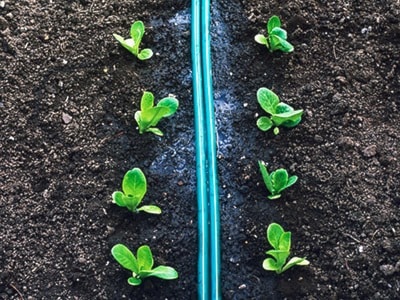Yes, it is very dry out there and yes, your plants need water, but so many folks will lose plants because of not knowing how best to water. Over-watering, watering at the wrong time of day (which can cause plant diseases) and not watering thoroughly are all poor watering practices. Watering is an art, and when done well, will help plants thrive and at the same time will preserve this precious resource.
If you have a choice, always water in the early morning as the temperature is on the rise. Doing so will allow plants to make the most efficient use of the water, and they will not transpire the moisture away as they will with evening watering. During the warmest part of the day is when plants need that moisture to prevent heat stress and other related problems.
When you water, make sure that you water thoroughly and that the water penetrates deep into the soil so the moisture goes down to the roots where it is needed. This is especially true for trees and shrubs. Thorough watering will encourage roots to grow deep and be less dependent on frequent watering. One of my greatest concerns is for the thousands of hedging cedars surrounding most homes. After a few years, we tend to forget about them, not realizing they are very shallow rooted, and like rhododendrons, need adequate water to keep them healthy and not stressed out. Soaker hoses to the rescue here at least on a weekly basis. Once the watering is done, dig down and check to see just how far it has penetrated into your soil.
Lawns, too, only need to be watered once a week during hot weather, but again, make sure you let the water penetrate down to the roots so they grow deep and the grass becomes more self-sufficient. This is why aeration of lawns in the spring and fall is so important. Aerating and then applying a ¼” layer of sharp sand will allow maximum penetration of water and will help your grass roots grow deep. The latest research from the turf industry also suggests keeping your grass cut lower, at approximately 2” (5cm) in order to reduce evening transpiration and to conserve moisture. A little browning is not a bad thing. When the rains return, the green colour will reappear rather quickly.
Vegetable gardens are the most challenging in the heat. If you always water in the morning and water only the root zones of all your plants, this will go a long ways to prevent diseases like mildew, botrytis and even blight on potatoes and tomatoes.
Planters and baskets offer a different challenge, especially when it’s so hot. Water them thoroughly in the morning so they’re less stressed during the day. But before you water them again, feel the weight of the basket and make sure it feels light. If it feels heavy, it is already wet enough, and you should wait until it dries out before watering again. Over-watering is worse than under-watering because the roots may rot with too much water, especially with fuchsias. With planters and baskets, it’s important to feed more frequently because you’re leaching out nutrients every time you water. This is where slow-release fertilizers, like 14-14-14, play such an important role in keeping your baskets continually fed, especially when we water so often at this time of the year.
When you water, please use a water breaker with at least 400-1000 holes at the end of your hose for the most efficient distribution of water into the soil, and always use a wand so you are not constantly having to bend over. Shallow and frequent watering will make most of your garden plants less self-sufficient and more dependent on watering - so water less often but more thoroughly and deeply. Focus on watering the root systems and try to water in the morning for the most resourceful use of water. Soaker hoses and drip systems are the most effective way to save you time and to use less water.
